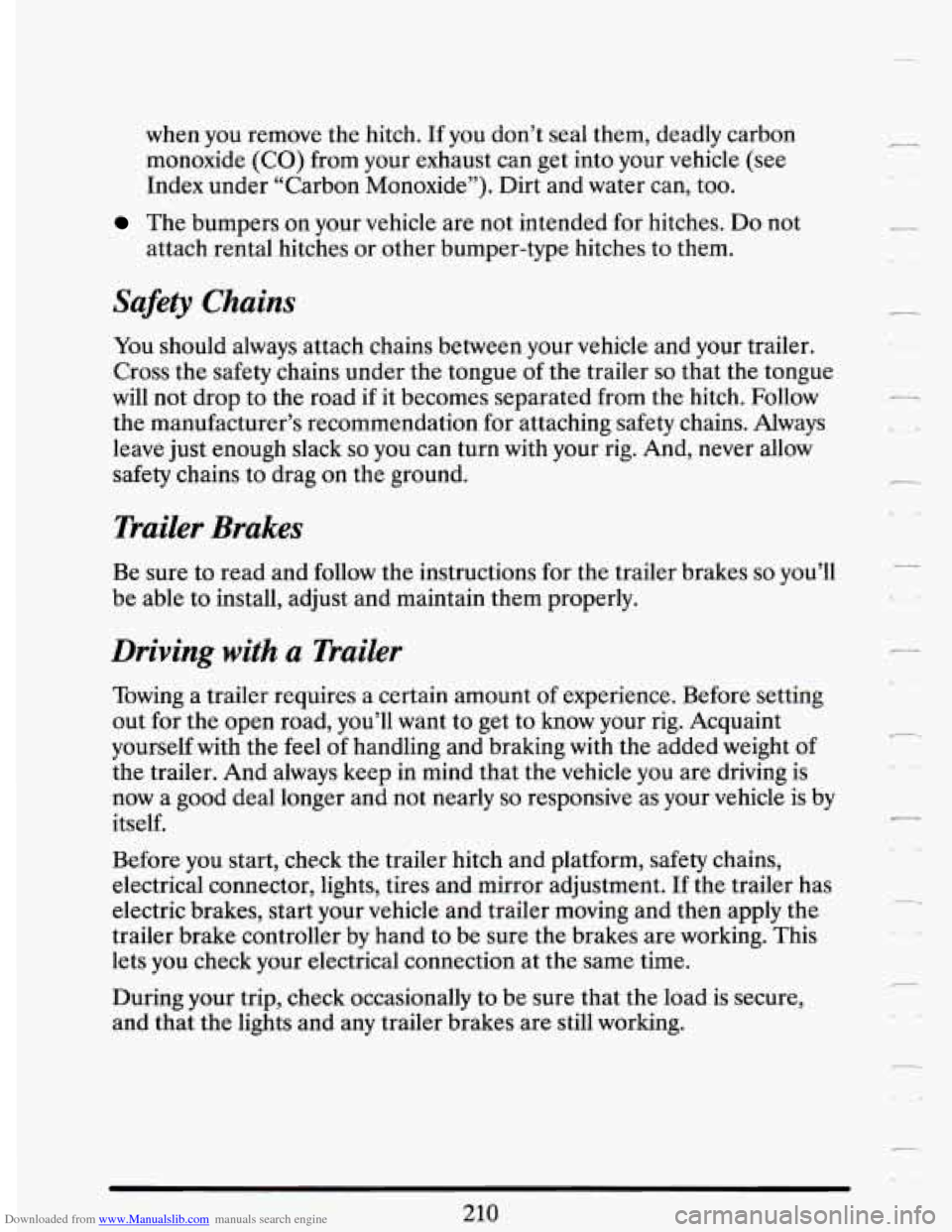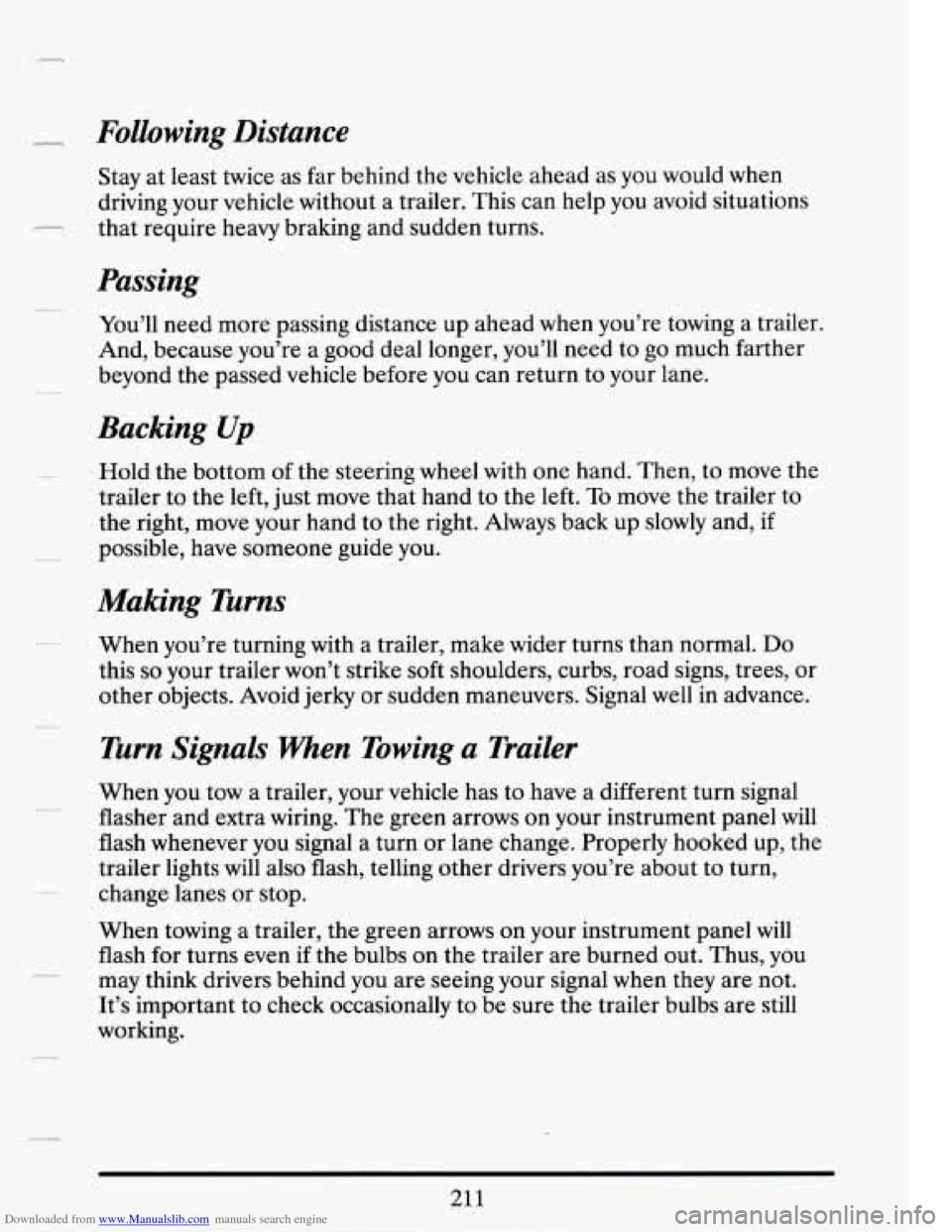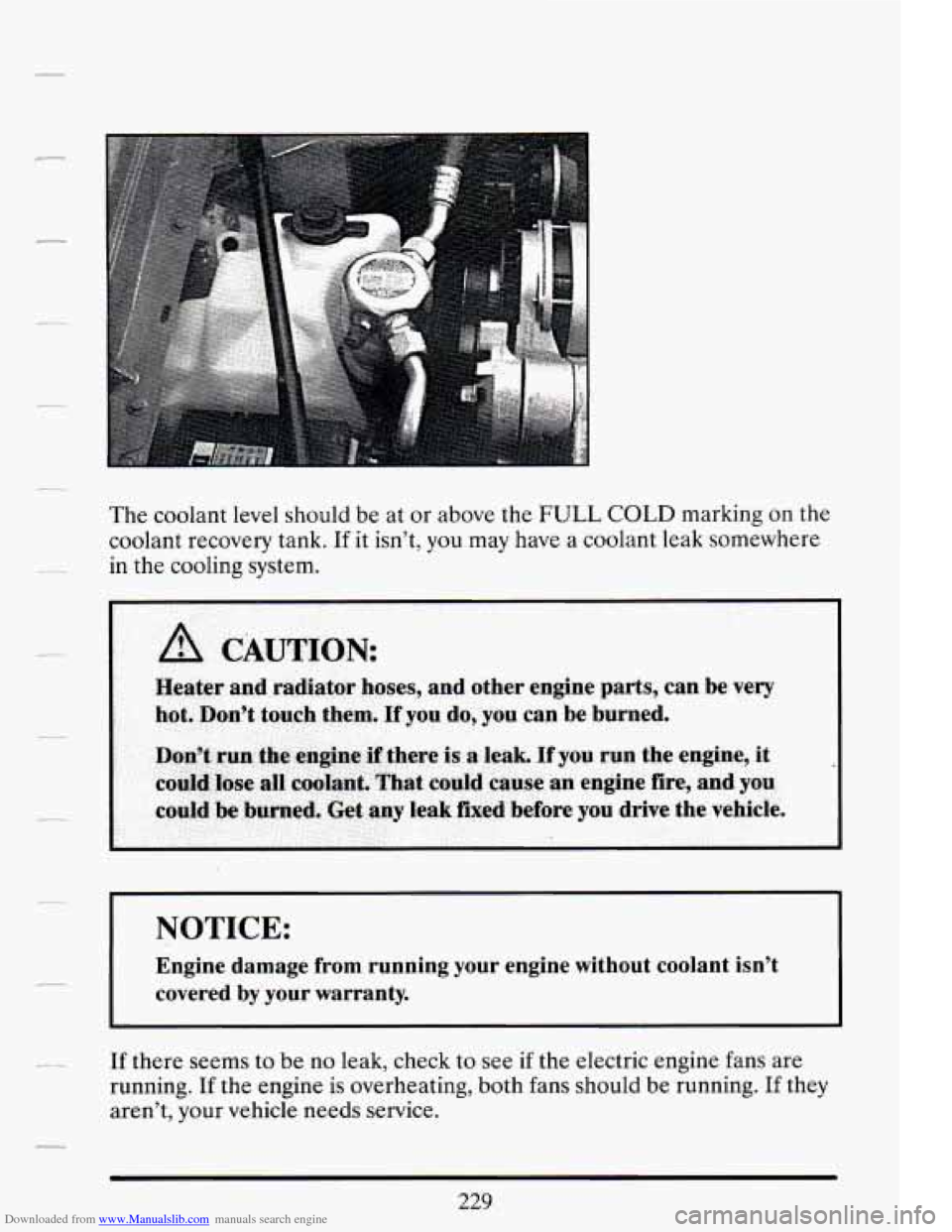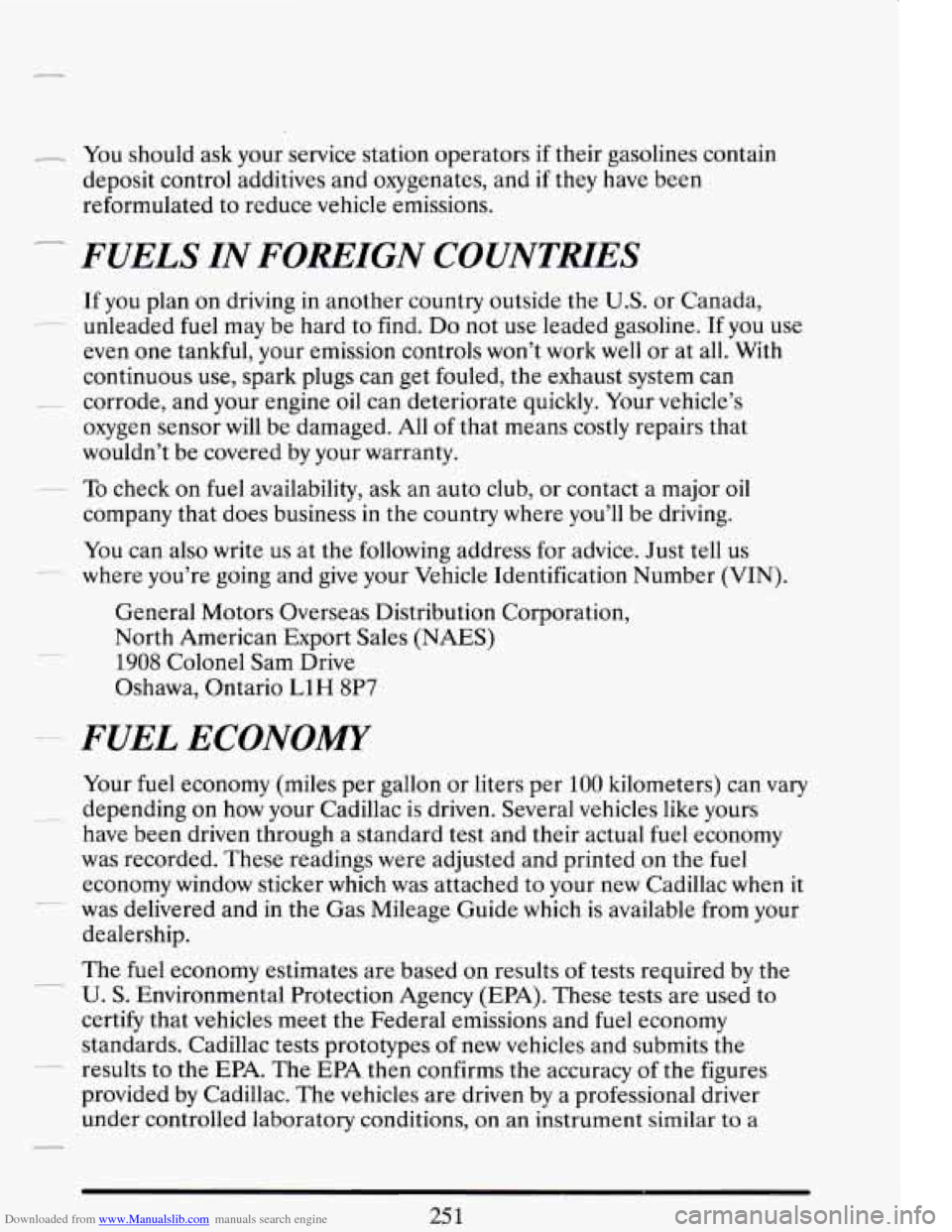check engine CADILLAC DEVILLE 1994 7.G Owner's Guide
[x] Cancel search | Manufacturer: CADILLAC, Model Year: 1994, Model line: DEVILLE, Model: CADILLAC DEVILLE 1994 7.GPages: 399, PDF Size: 20.97 MB
Page 223 of 399

Downloaded from www.Manualslib.com manuals search engine when you remove the hitch. If you don’t seal them, deadly carbon
monoxide
(CO) from your exhaust can get into your vehicle (see
Index under “Carbon Monoxide”). Dirt and water can, too.
attach rental hitches or other bumper-type hitches to them.
The bumpers on your vehicle are not intended for hitches. Do not
Safety Chains
You should always attach chains between your vehicle and your trailer.
Cross the safety chains under the tongue of the trailer so that the tongue
will not drop to the road
if it becomes separated from the hitch. Follow
the manufacturer’s recommendation for attaching safety chains. Always
leave just enough slack
so you can turn with your rig. And, never allow
safety chains to drag
on the ground.
Trailer Brakes
Be sure to read and follow the instructions for the trailer brakes so you’ll
be able to install, adjust and maintain them properly.
Driving with a Trailer
Towing a trailer requires a certain amount of experience. Before setting
out for the open road, you’ll want to get to
know your rig. Acquaint
yourself with the
feel of handling and braking with the added weight of
the trailer. And always keep
in mind that the vehicle you are driving is
now a good deal longer and not nearly
so responsive as your vehicle is by
itself.
Before you start, check the trailer hitch and platform, safety chains,
electrical connector, lights, tires and mirror adjustment. If the trailer has
electric brakes, start your vehicle and trailer moving and then apply the
trailer brake controller by hand to be sure the brakes are working. This
lets you check your electrical connection at the same time.
During your trip, check occasionally to be sure that the load is secure,
and that the lights and any trailer brakes are still working.
r
c.
.-
r.
Page 224 of 399

Downloaded from www.Manualslib.com manuals search engine Following Distance
--
>-
Stay at least twice as far behind the vehicle ahead as you would when
driving your vehicle without
a trailer. This can help you avoid situations
that require heavy braking and sudden turns.
Passing
You’ll need more passing distance up ahead when you’re towing a trailer.
And, because you’re a good deal longer, you’ll need to go much farther
beyond the passed vehicle before you can return to your lane.
Bucking Up
Hold the bottom of the steering wheel with one hand. Then, to move the
trailer
to the left, just move that hand to the left. To move the trailer to
the right, move your hand to the right. Always back up slowly and,
if
possible, have someone guide you.
Making Turns
When you’re turning with a trailer, make wider turns than normal. Do
this so your trailer won’t strike soft shoulders, curbs, road signs, trees, or
other objects. Avoid jerky or sudden maneuvers. Signal
well in advance.
Turn Signals When Towing a Trailer
When you tow a trailer, your vehicle has to have a different turn signal
flasher and extra wiring. The green arrows on your instrument panel
will
flash whenever you signal a turn or lane change. Properly hooked up, the
trailer lights will also flash, telling other drivers you’re about to turn,
change lanes or stop.
When towing a trailer, the green arrows on your instrument panel
will
flash for turns even if the bulbs on the trailer are burned out. Thus, you
may think drivers behind you are seeing your signal when they are not.
It’s important to check occasionally to be sure the trailer bulbs are still
working. -
21 1
Page 226 of 399

Downloaded from www.Manualslib.com manuals search engine 3. Drive slowly until the trailer is clear of the chocks.
4. Stop and have someone pick up and store the chocks.
Engine Cooling When Trailering
Your cooling system may temporarily overheat during severe operating
conditions such as;
Climbing grades steeper than 4% at ambient temperatures above
90” Fahrenheit (32’Celsius) with a loaded vehicle and trailer.
Stopping after high-speed driving.
Idling for long periods in stop and go traffic.
If “ENGINE
HOT A/C COMPRESSOR OFF” message appears on the
Driver Information Center, do not be alarmed. This is a normal function
designed to reduce the load on the engine and cooling system you can
continue to drive your vehicle.
If “ENGINE COOLANT
HOT” message appears on the Driver
Information Center, pull off to the side of
the road as soon as it is safe to
do so. When the vehicle is at a complete stop, shift the transmission
selector to
P (Park) and allow the engine to idle. Do not turn off the
engine or increase engine speed above a normal idle. Within
two or three
minutes the system should cool sufficiently to allow
A/C operation to
resume. At that
time resume driving at a reduced speed. Return to
normal driving after
10 minutes if the “ENGINE COOLANT HOT”
message
is not displayed.
Maintenance when Trailer Towing
Your vehicle will need service more often when you’re pulling a trailer.
See
the Maintenance Schedule for more on this. Things that are
especially important
in trailer operation are automatic transaxle fluid
(don’t overfill), engine oil, belts, cooling system, and brake wear. Each of
these is covered
in this manual, and the Index will help you find them
quickly. If you’re trailering, it’s a good idea to review these sections
before
you start your trip.
Check periodically
to see that all hitch nuts and bolts are tight.
213
Page 230 of 399

Downloaded from www.Manualslib.com manuals search engine JUMP STARTING
If your battery has run down, you may want to use another vehicle and
some jumper cables
to start your Cadillac . But please follow the steps
below
to do it safely.
-
NOTICE:
Ignoring these steps could result in costly damage to your
vehicle that wouldn’t be covered by your warranty.
Trying to start your Cadillac by pushing or pulling it won’t
work, and it could damage your vehicle.
TO JUMP START YOUR CXDILLAC:
1. Check the other vehicle. It must have a 12-volt battery with a negative
ground system.
NOTICE:
If the other system isn’t a 12-volt system with a negative ground,
both vehicles can be damaged.
Page 232 of 399

Downloaded from www.Manualslib.com manuals search engine 5. Start by removing the red positive (+) terminal cover.
6. Check that the jumper cables don’t have loose or missing insulation. If
they do, you could get a shock. The vehicles could be damaged, too.
Before you connect the cables, here are some things you should know.
Positive
(+) will go to positive (+) and negative (-) will go to negative
219
Page 242 of 399

Downloaded from www.Manualslib.com manuals search engine The coolant level should be at or above the FULL COLD marking on the
coolant recovery tank.
If it isn’t, you may have a coolant leak somewhere
in the cooling system.
NOTICE:
Engine damage from running your engine without coolant isn’t
covered by your warranty.
If there seems to be no leak, check to see if the electric engine fans are
running.
If the engine is overheating, both fans should be running. If they
aren’t, your vehicle needs service.
229
Page 258 of 399

Downloaded from www.Manualslib.com manuals search engine b__ Don’t try to put a wheel cover on your compact spare tire. It won’t fit.
Store the wheel cover in the trunk until you have the flat tire repaired or
replaced.
c_
I
I NOTICE:
~. Wheel covers won’t fit on your compact spare. If you try to put a
wheel cover on your compact spare, you
could damage the cover
or the spare.
1
L
]
COMPACT SPARE TIRE
~ Although the compact spare was fully inflated when your vehicle was
new,
it can lose air after a time. Check the inflation pressure regularly. It
should be
60 psi (420 kPa). After installing the compact spare on your
is correctly inflated. The compact spare is made to perform well at posted
speed limits for distances up
to 3,000 miles (5 000 km). The compact
~ spare is made to go up to 3,000 miles (5 000 km), so you can finish your
trip and have
your full-size. tire repaired or replaced where you want. Of
course, it’s best to replace your spare with a full-size tire as soon as you
can. Your spare will last longer and
be in good shape in case you need it
again.
Your anti-lock brake system warning light may come on when you are
Light” in the Index.
-_ vehicle, you should stop as soon as possible and make sure your spare tire
I__ driving with a compact spare. See “Anti-Lock Brake System Warning
245
Page 261 of 399

Downloaded from www.Manualslib.com manuals search engine CI
I
I
Y ciii I
SERVICE AND APPEARANCE CARE
Here you will find information about the care of your Cadillac. This
section begins with service and fuel information, and then it shows how to
check important fluid and lubricant levels. There is also technical
information about your vehicle, and a section devoted to its appearance
care.
Your Cadillac dealer knows your vehicle best and wants you to be happy
with it. We hope you’ll
go to your dealer for all your service needs. You’ll
get genuine
GM parts and GM-trained and supported service people.
We hope
you’ll want to keep your GM vehicle all GM. Genuine GM parts
have one
of these marks:
Doing Your Own Service Work
If you want to do some of your own service work, you’ll want to get the
proper Cadillac Service Manual. It tells you much more about how to
service your Cadillac than this manual can.
To order the proper service
manual,
see “Service Publications” in the Index.
Your vehicle has an air bag system. Before attempting to do your own
service
work, see “Servicing Your Air Bag-Equipped Cadillac” in the
Index.
248
Page 264 of 399

Downloaded from www.Manualslib.com manuals search engine - You should asK your service station operators if their gasolines contain
deposit control additives and oxygenates, and
if they have been
reformulated to reduce vehicle emissions.
- FUELS IN FOREIGN COUNTMES
If you plan on driving in another country outside the U.S. or Canada,
.+- unleaded fuel may be hard to find. Do not use leaded gasoline. If you use
even one tankful, your emission controls won’t work well or at all. With
continuous use, spark plugs can get fouled, the exhaust system can
-- corrode, and your engine oil can deteriorate quickly. Your vehicle’s
oxygen sensor will be damaged. All
of that means costly repairs that
wouldn’t be covered by your warranty.
~ To check on fuel availability, ask an auto club, or contact a major oil
company that does business in the country where you’ll be driving.
You can also write us at the following address for advice. Just tell us
__ where you’re going and give your Vehicle Identification Number (VIN).
General Motors Overseas Dist:ribution Corporation,
North American Export Sales (NAES)
1908 Colonel Sam Drive
Oshawa, Ontario
L1H 8P7
---. FUEL ECONOMY
Your fuel economy (miles per gallon or liters per 100 kilometers) can vary
have been driven through a standard test and their actual fuel economy
was recorded. These readings were adjusted and printed on the fuel
economy window sticker which was attached to your new Cadillac when it
-- was delivered and in the Gas Mileage Guide which is available from your
dealership.
~. depending on how your Cadillac is driven. Several vehicles like yours
The fuel economy estimates are based on results
of tests required by the
U. S. Environmental Protection Agency (EPA). These tests are used to
certify that vehicles meet the Federal emissions and fuel economy
standards. Cadillac tests prototypes of new vehicles and submits the
- results to the EPA. The EPA then confirms the accuracy of the figures
provided by Cadillac. The vehicles are driven by a professional driver
under controlled laboratory conditions, on an instrument similar
to a
w.
25 1
Page 270 of 399

Downloaded from www.Manualslib.com manuals search engine CHECKING THINGS UNDER THE HOOD
Hood Release
---
.-
To open the hood, first pull the lever inside the vehicle located at the
lower left side
of the instrument panel.
Then
go the front of the vehicle and release the secondary hood release
and lift the hood.
257